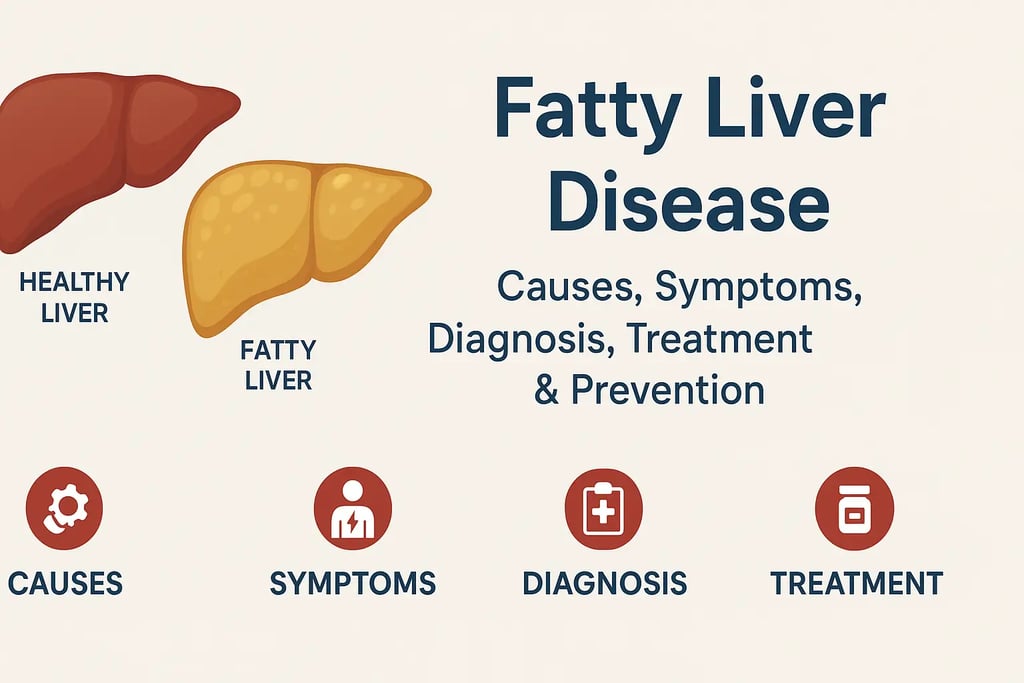Fatty Liver Disease: Causes, Symptoms, Diagnosis, Treatment & Prevention
Learn about fatty liver disease (hepatic steatosis) — its causes, symptoms, diagnosis, and treatment options. Discover effective ways to prevent and manage fatty liver naturally.


🩺 What is Fatty Liver? Causes, Symptoms, Diagnosis, and Treatment
Fatty liver disease, also known as hepatic steatosis, is a medical condition where excess fat builds up in the liver cells. This fat accumulation can interfere with normal liver functions, leading to inflammation and long-term liver damage if not managed properly. Fatty liver is mainly divided into two types — Alcoholic Fatty Liver Disease (AFLD) and Non-Alcoholic Fatty Liver Disease (NAFLD).
AFLD develops due to excessive alcohol consumption, causing liver inflammation and scarring.
NAFLD, on the other hand, occurs in individuals who consume little or no alcohol. It is often linked to obesity, type 2 diabetes, high cholesterol, and metabolic syndrome.
Understanding the underlying causes, symptoms, and preventive measures is essential for maintaining a healthy liver and overall well-being.
🧬 How Fatty Liver Develops
Fatty liver occurs when the liver fails to properly process and break down fats. Normally, the liver metabolizes fat for energy or sends it to other parts of the body. However, when fat production exceeds the liver’s capacity to metabolize or export it, fat begins to accumulate within liver cells.
Over time, this can cause:
Inflammation (hepatitis)
Fibrosis (scarring)
Cirrhosis (severe liver damage)
The buildup of fat can disrupt vital metabolic functions, affecting the liver’s ability to filter toxins, regulate hormones, and produce essential proteins.
⚠️ Common Causes of Fatty Liver Disease
Several factors contribute to the development of fatty liver disease, including lifestyle, diet, and genetics. The major causes include:
1. Obesity
Excess body fat, particularly around the abdomen, is a major risk factor. Obesity causes insulin resistance, leading to increased fat storage in the liver.
2. Type 2 Diabetes
High blood sugar levels and insulin resistance cause fat to accumulate in the liver, worsening liver function over time.
3. High Cholesterol and Triglycerides
Uncontrolled lipid levels disrupt fat metabolism, increasing the likelihood of fatty liver.
4. Alcohol Consumption
Chronic alcohol intake damages liver cells, triggering inflammation and fat buildup — the hallmark of alcoholic fatty liver disease.
5. Sedentary Lifestyle
Lack of exercise contributes to weight gain and poor fat metabolism, accelerating fat storage in the liver.
6. Poor Diet
Diets rich in sugars, refined carbohydrates, and unhealthy fats play a major role in the onset of fatty liver disease.
7. Genetic Factors
Some individuals may develop fatty liver despite maintaining a healthy lifestyle, suggesting a genetic predisposition.
🩸 Symptoms of Fatty Liver Disease
In its early stages, fatty liver disease is often silent and asymptomatic. As the condition progresses, patients may begin to notice certain symptoms, including:
Persistent fatigue and weakness
Discomfort or pain in the upper right abdomen
Unexplained weight loss or loss of appetite
Nausea or indigestion
Jaundice (yellowing of the skin or eyes) in advanced cases
Swelling in the abdomen (ascites) or legs due to fluid buildup
Easy bruising due to impaired liver function
Recognizing these signs early and consulting a healthcare provider can help prevent serious liver complications.
🧪 Diagnosis of Fatty Liver
Diagnosing fatty liver disease involves several steps to determine its presence and severity:
1. Medical Evaluation
Doctors begin with an assessment of medical history, diet, alcohol intake, and lifestyle habits.
2. Blood Tests
Liver function tests (LFTs) check for elevated enzymes such as ALT and AST, which may indicate liver inflammation.
3. Imaging Tests
Ultrasound is often the first test used to detect liver fat.
CT scans and MRI scans provide a more detailed view of fat distribution and liver structure.
4. Liver Biopsy
In some cases, a small tissue sample is collected to confirm the diagnosis and measure the extent of liver damage or fibrosis.
Accurate diagnosis ensures timely management and helps prevent progression to severe liver diseases like cirrhosis.
💊 Treatment Options for Fatty Liver Disease
Currently, there is no specific medication approved solely for treating fatty liver disease. However, effective management and reversal are possible through a combination of lifestyle and medical interventions:
1. Weight Loss
Losing 5–10% of body weight can significantly reduce fat in the liver and improve overall liver health.
2. Healthy Diet
Adopting a Mediterranean diet—rich in fruits, vegetables, whole grains, lean proteins, and healthy fats like olive oil—can improve liver function.
Avoid sugary drinks, processed foods, and fried items.
3. Regular Exercise
Engaging in at least 150 minutes of moderate exercise per week helps burn fat and improve insulin sensitivity.
4. Limit Alcohol Consumption
Even moderate drinking can worsen liver damage in individuals with fatty liver.
5. Medical Treatments
In severe cases, doctors may prescribe:
Insulin-sensitizing drugs
Vitamin E supplements (for non-alcoholic fatty liver)
Liver transplant in extreme, irreversible damage cases
A holistic approach combining diet, physical activity, and medical supervision offers the best outcomes.
🥗 How to Prevent Fatty Liver Disease
Preventing fatty liver is easier than reversing it. Key preventive strategies include:
Maintain a healthy weight through balanced nutrition and regular workouts
Limit processed and sugary foods
Monitor cholesterol and blood sugar levels regularly
Avoid excessive alcohol consumption
Get regular health check-ups to detect early signs of liver stress
A proactive lifestyle ensures better liver health and reduces the risk of related metabolic conditions.
💬 Living with Fatty Liver: Support and Awareness
Living with fatty liver disease can be emotionally and physically challenging. Many patients experience fatigue, dietary restrictions, and anxiety about their health. Support from healthcare professionals, nutritionists, and liver health communities can make a big difference.
Joining online support groups, attending nutrition workshops, and sharing experiences with others help patients stay motivated. With consistent management and emotional support, it’s entirely possible to lead a healthy, fulfilling life even after diagnosis.
✅ Key Takeaway
Fatty liver disease is increasingly common, but early detection and lifestyle changes can reverse its effects. By adopting a balanced diet, exercising regularly, and minimizing alcohol consumption, individuals can protect their liver and promote long-term wellness.
